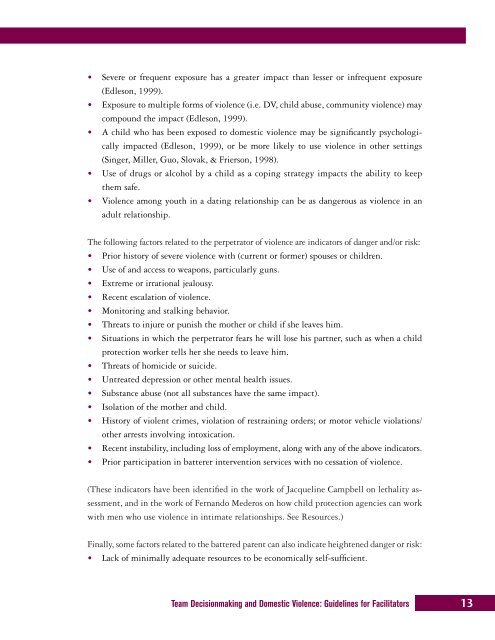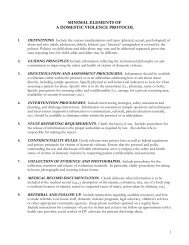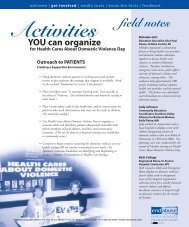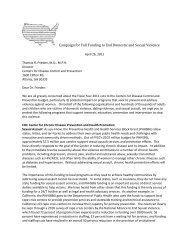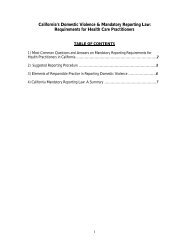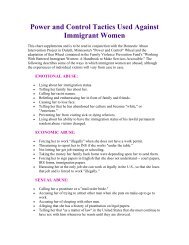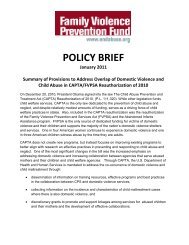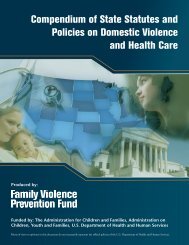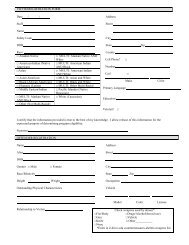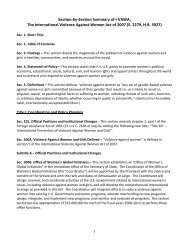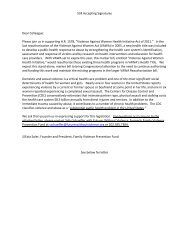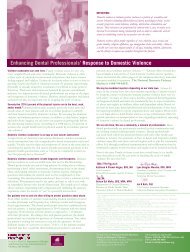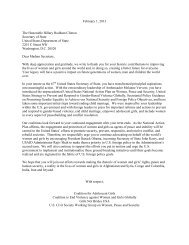Team Decisionmaking and Domestic Violence: Guidelines for ...
Team Decisionmaking and Domestic Violence: Guidelines for ...
Team Decisionmaking and Domestic Violence: Guidelines for ...
Create successful ePaper yourself
Turn your PDF publications into a flip-book with our unique Google optimized e-Paper software.
• Severe or frequent exposure has a greater impact than lesser or infrequent exposure<br />
(Edleson, 1999).<br />
• Exposure to multiple <strong>for</strong>ms of violence (i.e. DV, child abuse, community violence) may<br />
compound the impact (Edleson, 1999).<br />
• A child who has been exposed to domestic violence may be significantly psychologically<br />
impacted (Edleson, 1999), or be more likely to use violence in other settings<br />
(Singer, Miller, Guo, Slovak, & Frierson, 1998).<br />
• Use of drugs or alcohol by a child as a coping strategy impacts the ability to keep<br />
them safe.<br />
• <strong>Violence</strong> among youth in a dating relationship can be as dangerous as violence in an<br />
adult relationship.<br />
The following factors related to the perpetrator of violence are indicators of danger <strong>and</strong>/or risk:<br />
• Prior history of severe violence with (current or <strong>for</strong>mer) spouses or children.<br />
• Use of <strong>and</strong> access to weapons, particularly guns.<br />
• Extreme or irrational jealousy.<br />
• Recent escalation of violence.<br />
• Monitoring <strong>and</strong> stalking behavior.<br />
• Threats to injure or punish the mother or child if she leaves him.<br />
• Situations in which the perpetrator fears he will lose his partner, such as when a child<br />
protection worker tells her she needs to leave him.<br />
• Threats of homicide or suicide.<br />
• Untreated depression or other mental health issues.<br />
• Substance abuse (not all substances have the same impact).<br />
• Isolation of the mother <strong>and</strong> child.<br />
• History of violent crimes, violation of restraining orders; or motor vehicle violations/<br />
other arrests involving intoxication.<br />
• Recent instability, including loss of employment, along with any of the above indicators.<br />
• Prior participation in batterer intervention services with no cessation of violence.<br />
(These indicators have been identified in the work of Jacqueline Campbell on lethality assessment,<br />
<strong>and</strong> in the work of Fern<strong>and</strong>o Mederos on how child protection agencies can work<br />
with men who use violence in intimate relationships. See Resources.)<br />
Finally, some factors related to the battered parent can also indicate heightened danger or risk:<br />
• Lack of minimally adequate resources to be economically self-sufficient.<br />
<strong>Team</strong> <strong>Decisionmaking</strong> <strong>and</strong> <strong>Domestic</strong> <strong>Violence</strong>: <strong>Guidelines</strong> <strong>for</strong> Facilitators 13


